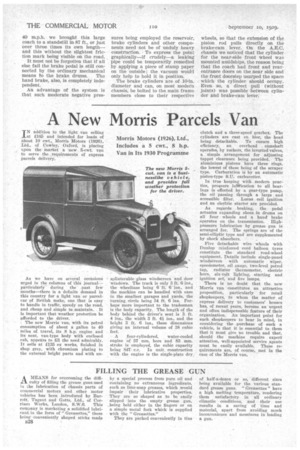A New Morris Parcels Van
Page 54

If you've noticed an error in this article please click here to report it so we can fix it.
IN addition to the l'ght van selling at 4165 and intended for loads of about 10 cwt., Morris Motors (1926), Ltd., of Coley, Oxford, is placing upon the market a new 5-cwt. van to serve the .requirements of express
parcels delivery. • As we have on several occasions urged in the columns of this journal— particularly during the .past few months—there is a definite demand in this country for a light van or parcelcar of British make, one that is easy to handle in traffic, speedy on the road, and cheap and simple tO maintain. It is important that weather protection be afforded to the driver.
The new Morris van, with its petrol consumption of about a gallon to 40 miles of travel,. its 8 h.p. engine and its neat, van-type body with enclosed cab, appears to fill the need admirably. It sells at £135 ex works, finished in shop grey, with chromium plating to the external bright parts and with un
splinterable glass windscreen and door 'windows. The track is only 3 ft. 6 ins.,
• the wheelbase being 6 ft. 6 ins., and the machine can be handled with ease in the smallest garages and yards, the turning circle being 34 ft. 6 ins. Perhaps more important to the tradesman is the body capacity. The length of the body behind the driver's seat is 3 ft. 4 ins., the width 3 ft. 41 ins., and the height 3 ft. 6 ins., these dimensions giving an internal volume of 38 cubic feet.
A four-cylinclered, water-cooled engine of 57 mm. bore and 83 mm. stroke is employed, the cubic capacity being 847. c.c. In unit construction with the engine is the single-plate dry, clutch and a three-speed gearbox. The cylinders are cast en bloc, the head being detachable. To ensure high efficiency, an overhead . camshaft operates, by rockers, the inverted valves, a simple arrangement for adjusting tappet clearance being provided. The aluminiumi pistons have three rings, the lowest of these being of the scraper type. Carburation is by an automatic piston-type S.U. carburetter.
• In true keeping with modern practice, pressure lulitication to all bearings is effected by a gear-type pump, the oil passing through a large and
accessible filter. Lucas coil ignition and an electric starter are provided.
As regards braking, the pedal actuates expanding shoes in drums on all four wheels and a hand brake operates on the transmission. Highpressure lubrication by grease gun is arranged for. The springs are of the semi-elliptic type and are supplemented by shock absorbers. .
Five detachable wire wheels with Dunlop reinforced cord balloon tyres constitute the standard road-wheel equipment. Details include single-panel windscreen with automatic wiper, speedometer, oil gauge, two-level petrol tap, radiator thermometer, electric horn, six-volt lighting, starting and ignition set, and five lamps.
There is no doubt that the new Morris van constitutes an attractive proposition, particularly for retail shopkeepers, to whom the matter of express delivery to customers' houses has, of recent years, become an urgent and often indispensable feature of their organization. An important point for such shopkeepers to bear in mind, in considering the purchase of such a vehicle, is that it is essential to them that it must give no trouble and that, should the machine require expert attention, well-appointed service agents must be easily available. These requirements are, of course, met in the case of the Morris van.




















































































































